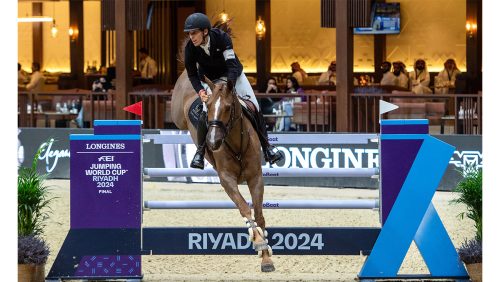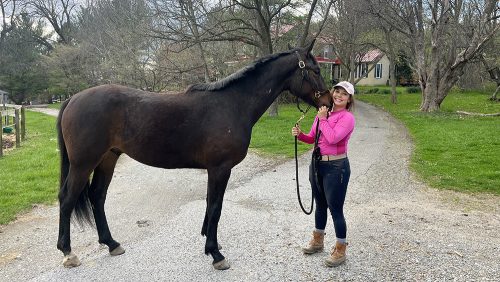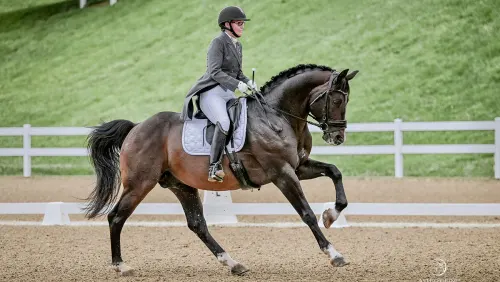Our columnist delves into the ongoing discussion of safety helmets, head injuries and personal choice.
A few weeks before Courtney Dye’s horrible riding accident that left her with severe head injuries, she took part in a U.S. Equestrian Federation High Performance clinic in Florida working with Steffen Peters and me.
As always when I watched Courtney ride, I admired her instinctive and extraordinary ability to bring out whatever positive features a horse may possess. At the end of the day, Courtney showed me a video of a couple of horses for potential sponsorship, and we discussed which one of them would be the best match for her to make into a future team horse.
Fast forward to the Palm Beach Derby (Fla.) the first weekend in February, when I observed trainer Lendon Gray receive a phone call by ringside and heard her exclaim: “That’s awful!” Now we all know what she found out on that call.
During the show, there was a moving ceremony with prayers to bring Courtney out of her coma. And, thank God, today she’s not only awake but also recovering quite well.
Courtney isn’t my only close experience with head injuries due to a horse that fell. I had a very experienced student in New York whose horse stumbled and fell with her at the walk. This rider is still in a coma, three years later. I wasn’t present, but the description of the accident was as undramatic as any event could be, and yet the consequences are devastating. I stood at my student’s bed at the hospital fully aware that our roles could just as easily have been reversed.
Neither rider wore a protective helmet at the time of the accidents. Would their injuries have been less severe if they’d worn safety headgear? Since all research indicates that this is the case, the debate about mandatory regulations for safety helmets for dressage has intensified.
Just The Facts
ADVERTISEMENT
The subject was put on the Fédération Equestre Internationale Dressage Committee agenda at the last meeting, and the medical information that accompanied the issue presented the following facts and opinions:
- Head injuries appear to account for approximately 10 percent of horse-related injuries and are the injuries most likely to result in hospitalization or death.
- A fall from 60 cm (approximately 3′) can cause permanent brain damage, and a horse elevates the rider up to 3 m (9′) above the ground.
- A human skull can be shattered by impact at as low as 7km/hour, and the most likely ages for injury to occur are 5 to 14 and 25 to 44.
- In Great Britain, hospital admission for equestrian injuries declined 46 percent after helmet design improved and they entered routine use.
- The U.S. Pony Clubs decreased their head injury rate by 29 percent after mandatory helmet use.
You would think that the above information would make us all run for head cover, but that isn’t necessarily the case. The problem with dressage, as Dr. Craig Ferrell pointed out to the FEI Dressage Committee, is that while helmets are considered ugly, the top hat is considered elegant and is also highly traditional.
To some people, wearing a safety helmet with your shadbelly is tantamount to wearing a Speedo to a wedding. It’s simply the value of tradition over safety, especially when the risk of head injury appears remote, as it may seem in comparison to other riding disciplines.
In the wake of the debate comes, as always, the commercial aspect. Plans are afoot amongst the fashionable “hat makers to the stars.” They’re working to construct a product that looks like the traditional top hat but performs like a helmet.
Some of us experience real problems calling this image up in our minds, but others have no problem kissing tradition goodbye. One person said: “Top hats should be used by magicians, clowns, men in formal attire and people who need a vessel for their raffle tickets.”
It may be the responsibility of the international governing body to set policy, but the opposition to rule changes messing with tradition is strong. I have to admit that the image of the FEI rider in tails and top hat is so ingrained in our brains and closely identified with dressage that we in the committee had severe withdrawal symptoms at the mere thought of giving it up forever. Let me hasten to point out, though, that people have always been and definitely still are allowed to ride at all FEI levels with safety helmets.
Another side of the argument comes from the athletes: “I’ll do as I wish. It’s my right as an individual to choose whether or not to ride with a safety helmet.” Of course it is. And what you do at home cannot be easily regulated. At showgrounds and public riding stables, however, rules can be put in place and enforced. In some countries, I found out, the insurance companies will not pay for your hospital bill for a head injury—even at your own barn—if it can be proven that you weren’t wearing a safety helmet.
Helmet Hair
ADVERTISEMENT
This column has been difficult for me to write because I must confess I’ve spent most of my riding life, except when competing in eventing and jumping, without protective headgear.
I’ve had spectacular dismounts over jumps and from bucking horses and have broken various bones, but I know the falls on the flat are the most dangerous. When you get thrown up into the air before heading to the ground, there’s a split second of extra time when your body instinctively makes a move to protect the head. Perhaps your arm or shoulder pays the price, but not your brain. When the horse falls, there’s no such downtime. The ground comes at you before you have any chance to react, and it comes at you hard.
I know all the excuses for not wearing a helmet—it’s uncomfortable, too heavy, too hot, too tight and it kills my hair.
Then I go to the shows and see more and more dressage riders warming up with helmets. Our top Grand Prix riders, such as Guenter Seidel and Steffen Peters, are sporting snazzy designs in protective headgear. And during the Kentucky CDI last April, Canadian Grand Prix rider Jackie Brooks performed all of her tests at the show, including the freestyle at night in front of a sizeable audience, wearing her safety helmet right into the competition ring.
I’m sure some people were startled at the first glimpse of her, but as soon as the music started and she began a nice ride, they forgot about her hat.
It will be a challenge to the dressage world to make the use of safety helmets accepted and appropriate and eventually desirable. I think perhaps we can police ourselves and not have to make rules a necessity.
For sure, I’m starting to feel self-conscious riding around in my baseball cap. As a friend of mine said when we discussed this issue: If your head is less important than your hair, I guess there’s not much in it!
Anne Gribbons moved to the United States from Sweden in 1972 and has trained more than a dozen horses to Grand Prix. She rode on the 1986 World Championships dressage team and earned a team silver medal at the 1995 Pan American Games. An O-rated dressage judge based in Chuluota, Fla., Gribbons serves as a longstanding member of the USEF High Performance Committee and is on the FEI Dressage Committee. She started contributing to Between Rounds in 1995.















